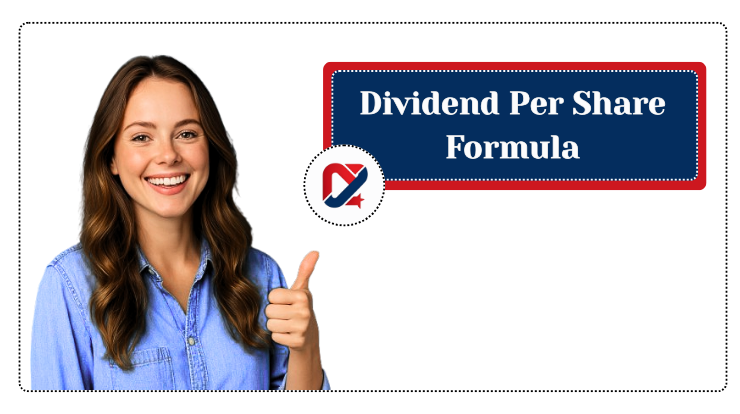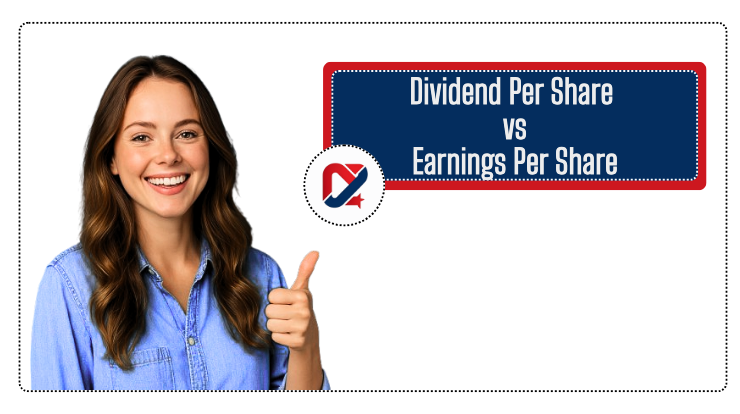Join WhatsApp Group
Join NowImagine you’re an investor scanning the stock market for reliable income streams. That’s where Dividend Per Share (DPS) comes in—a key metric that shows how much cash a company returns to its shareholders per share. In simple terms, DPS measures the portion of profits distributed as dividends to common stockholders. It’s a vital tool in finance for evaluating a company’s generosity toward investors and its financial health.
Why does DPS matter? For income-focused investors, like retirees or those building passive portfolios, it signals steady cash flow potential. Growth-oriented folks might use it to gauge reinvestment strategies. In volatile markets, high DPS stocks often provide a buffer against price swings. Understanding the dividend per share formula helps you compare companies apples-to-apples, spot dividend aristocrats, and make informed decisions. Whether you’re new to investing or refining your strategy, mastering DPS in finance can boost your portfolio’s performance. Let’s dive deeper into what it means, how to calculate it, and why it’s essential.
Table of Contents
Dividend Per Share Meaning
Dividend Per Share, often abbreviated as DPS, represents the total dividends a company pays out to its shareholders divided by the number of outstanding shares. It’s essentially the dividend payout on a per-share basis, making it easier for investors to assess returns without getting bogged down in total figures.
At its core, DPS reflects a company’s commitment to sharing profits. Not all firms pay dividends—some reinvest everything for growth—but those that do use DPS to communicate value. For example, mature companies in stable industries like utilities or consumer goods often boast higher DPS, attracting conservative investors.
DPS isn’t just a number; it’s a window into corporate strategy. A rising DPS might indicate strong earnings and confidence in future cash flows, while a cut could signal trouble ahead. In finance, DPS helps calculate other ratios like dividend yield (DPS divided by stock price), which shows return on investment. It’s reported in annual reports, earnings calls, and financial databases, making it accessible for analysis.
Understanding DPS goes beyond basics. It distinguishes between regular dividends (quarterly or annual) and special one-time payouts. Preferred shareholders might get fixed dividends first, affecting common DPS. Overall, grasping the dividend per share meaning empowers you to evaluate stocks holistically, blending income potential with growth prospects.
Dividend Per Share Formula

The dividend per share formula is straightforward yet powerful for financial analysis. It calculates how much dividend income each share receives over a period, typically a year.
The basic formula is:
DPS = Total Dividends Paid / Number of Outstanding SharesHere, “Total Dividends Paid” includes all cash dividends distributed to common shareholders during the fiscal year. “Number of Outstanding Shares” is the average or year-end count of shares available to the public.
For precision, especially with preferred stocks, use:
DPS = (Total Dividends Paid - Preferred Dividends) / Average Outstanding Common SharesThis adjusts for preferred dividends, which are paid first. Average shares account for changes like buybacks or issuances during the year.
To apply the dividend per share formula step-by-step:
- Gather total dividends from the company’s income statement or cash flow statement.
- Subtract any preferred dividends if applicable.
- Find the average outstanding shares from the balance sheet (beginning + ending shares / 2).
- Divide the adjusted dividends by the shares.
This method ensures accuracy in how to calculate dividend per share, avoiding common pitfalls like ignoring share fluctuations.
Formula Explanation with Example Calculation
Let’s break down the dividend per share formula with a real-world example. Suppose Company XYZ reported $10 million in total dividends paid last year. They have no preferred stock, and the average outstanding common shares were 5 million.
Using the formula:
DPS = $10,000,000 / 5,000,000 = $2.00 per shareThis means each shareholder received $2 for every share owned.
Now, consider a more complex scenario with preferred dividends. Company ABC paid $15 million in total dividends, including $3 million to preferred shareholders. Average common shares: 8 million.
Adjusted formula:
DPS = ($15,000,000 - $3,000,000) / 8,000,000 = $12,000,000 / 8,000,000 = $1.50 per shareStep-by-step:
- Total dividends: $15M
- Subtract preferred: $15M – $3M = $12M
- Divide by shares: $12M / 8M = $1.50
This dividend per share example illustrates why adjustments matter—preferred dividends reduce the pool for common shares.
In practice, companies might declare dividends quarterly. To find annual DPS, sum them up. For instance, if quarterly dividends are $0.25, $0.30, $0.25, and $0.35, annual DPS = $1.15.
Analysts often use trailing twelve months (TTM) data for up-to-date calculations. Tools like Excel can automate this: Input dividends in one cell, shares in another, and use =DIVIDENDS/SHARES.
Remember, DPS can vary by share class. Always check the company’s filings for accurate data when learning how to calculate dividend per share.
Importance of Dividend Per Share for Investors
DPS plays a crucial role in investment decisions, offering insights beyond mere stock prices. For income investors, it’s a direct measure of cash returns. A stable or growing DPS signals reliable income, ideal for dividend-focused portfolios.
In finance, DPS helps assess sustainability. Companies with consistent DPS often have strong free cash flow, indicating efficient operations. This metric aids in dividend yield calculations: Yield = (DPS / Stock Price) x 100%. A higher yield might attract buyers, boosting demand.
Growth investors use DPS to spot undervalued stocks. A low DPS relative to earnings might mean room for increases, while high DPS could indicate maturity with limited reinvestment.
DPS also influences total returns. Reinvested dividends compound over time—studies show they account for a significant portion of long-term stock gains. For example, the S&P 500’s historical returns include about 40% from dividends.
Tax-wise, qualified dividends (meeting IRS criteria) are taxed favorably, making high-DPS stocks appealing in taxable accounts.
Globally, DPS varies by region. U.S. firms often prioritise buybacks, while European ones favour dividends. Investors use DPS to diversify internationally.
Overall, understanding DPS in finance empowers better portfolio construction, risk management, and alignment with financial goals. It’s not just a number—it’s a predictor of shareholder value.
Factors Affecting Dividend Per Share
Several elements influence a company’s DPS, shaping its dividend policy. Earnings are primary: Higher profits mean more funds for dividends. If net income rises, DPS often follows, assuming payout ratios stay constant.
Payout ratio—the percentage of earnings paid as dividends—affects DPS directly. A 50% ratio means half of profits go to shareholders. Companies adjust this based on growth needs.
Cash flow is critical. Even profitable firms might cut DPS if cash is tied in operations or investments. Free cash flow (operating cash minus capex) must cover dividends sustainably.
Industry norms play a role. Utilities might have high DPS due to stable revenues, while tech startups reinvest, yielding low or zero DPS.
Economic conditions impact, too. In recessions, companies conserve cash, reducing DPS. Inflation might erode real dividend value unless increased.
Board decisions factor in. Management sets dividend policies, considering shareholder expectations and long-term strategy. Special dividends can spike DPS temporarily.
Share count changes: Buybacks reduce outstanding shares, potentially increasing DPS without raising total dividends.
Regulatory requirements, like those for banks, mandate capital reserves, limiting DPS.
Taxes influence: Favourable dividend taxes encourage higher payouts.
Understanding these factors helps predict DPS trends, aiding in how to calculate dividend per share forecasts.
Limitations of DPS
While useful, DPS has drawbacks investors should note. It doesn’t reflect total shareholder returns—ignoring capital gains or losses. A high DPS might mask declining stock prices.
DPS can be manipulated. Companies might borrow to pay dividends, inflating DPS unsustainably. This “dividend trap” lures investors into risky stocks.
It overlooks growth potential. High-DPS firms often forgo reinvestments, lagging behind peers in innovation.
Comparisons across industries falter. A utility’s high DPS isn’t comparable to a biotech’s zero DPS, as contexts differ.
Past DPS doesn’t guarantee future payouts. Economic shifts or management changes can slash dividends overnight.
DPS ignores inflation. Nominal increases might not keep pace with rising costs, eroding purchasing power.
For international investors, currency fluctuations affect effective DPS.
It doesn’t account for share dilution from new issuances, potentially lowering future DPS.
Relying solely on DPS risks missing broader financial health indicators like debt levels or ROE.
In summary, while DPS in finance is valuable, pair it with other metrics for a balanced view.
Dividend Per Share vs Earnings Per Share
DPS and Earnings Per Share (EPS) are key metrics, but they serve different purposes. EPS shows profitability per share, while DPS focuses on distributions.

Here’s a comparison table:
| Aspect | Dividend Per Share (DPS) | Earnings Per Share (EPS) |
|---|---|---|
| Definition | Total dividends paid divided by outstanding shares | Net income minus preferred dividends divided by outstanding shares |
| Focus | Shareholder payouts | Overall profitability |
| Formula | DPS = Total Dividends / Shares | EPS = (Net Income – Preferred Dividends) / Shares |
| Investor Use | Income generation and yield calculation | Growth potential and valuation (e.g., P/E ratio) |
| Volatility | More stable, as dividends are policy-driven | Fluctuates with earnings |
| Example | If $2 DPS on $50 stock, yield = 4% | $5 EPS might signal strong growth if reinvested |
| Limitations | Doesn’t show reinvested earnings | Includes non-cash items like depreciation |
This table highlights how DPS complements EPS. Use both for comprehensive analysis—EPS drives potential DPS increases.
Frequently Asked Questions (FAQ)
What is the dividend per share formula?
The dividend per share formula is DPS = Total Dividends Paid / Number of Outstanding Shares. Adjust for preferred dividends if needed.
How to calculate dividend per share with an example?
For a company paying $5 million in dividends with 2 million shares: DPS = $5M / 2M = $2.50. See the example section for details.
Why is DPS important in finance?
DPS in finance helps evaluate income potential, company stability, and shareholder returns.
What’s a good dividend per share example?
Apple’s DPS has grown from $2.18 in 2016 to over $0.96 quarterly in recent years, showcasing consistent increases.
How does DPS differ from dividend yield?
DPS is the absolute payout per share; yield is DPS divided by stock price, showing percentage return.
Can DPS be negative?
No, DPS is always non-negative as dividends can’t be negative. Zero DPS means no payout.
How often is DPS paid?
Typically quarterly, but some companies pay annually or semi-annually.
Conclusion
Mastering the dividend per share formula unlocks smarter investing. From understanding its meaning to calculating with examples, DPS guides income strategies and risk assessment. While it has limitations, combining it with metrics like EPS provides a fuller picture. Whether hunting yields or evaluating stability, DPS remains a cornerstone in finance. Start applying these insights to your portfolio today for better returns.


